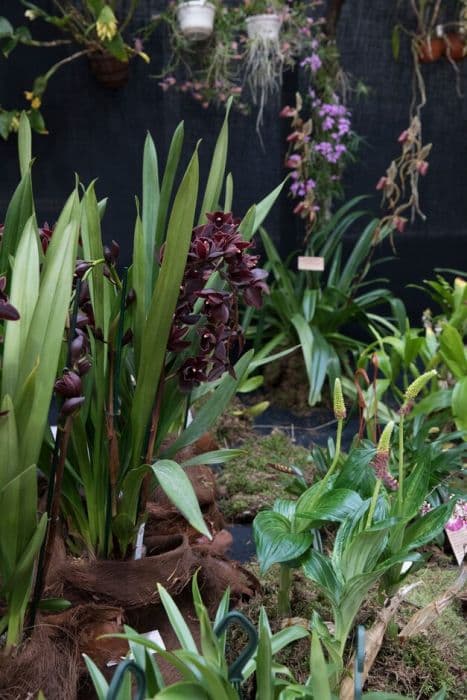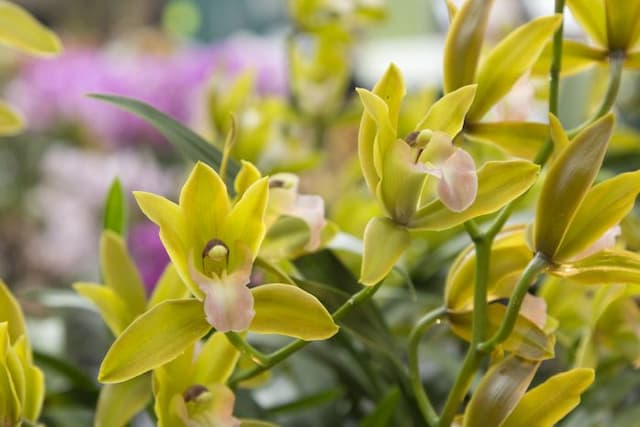Windowsill Orchid Pleione limprichtii

ABOUT
The plant in question, commonly known as Pleione limprichtii, bears a captivating charm with its visually stunning flowers. The blossoms are typically a rich shade, varying from soft pastel tones to vivid hues, displaying a range of colors that oftentimes includes pink, purple, or magenta. At the heart of each flower, there is a distinctive lip, which contrasts with the petals and sepals in both texture and color, drawing the attention of both pollinators and admirers alike. Each bloom is generally shaped like a tubular bell, opening gracefully to reveal its ornate interior. The petals and sepals radiate outward from the center, sometimes exhibiting delicate spots or striations that add depth and complexity to their appearance. Furthermore, the lip tends to be intricately decorated with ruffles, folds, or fringes and may even bear various patterns or markings, which can include spots or streaks that highlight its shape and form. The foliage of the Pleione limprichtii comprises slender leaves that emerge in pairs or as a single leaf from the base of the plant. These leaves bear a lush green color and exhibit a lanceolate or strap-shaped form, tapering to a point at the tip and clasping at the base. The texture of the leaves is generally smooth with a glossy sheen on the surface, contributing to the overall elegance of the plant. It's worth noting that this plant often emanates a gentle fragrance from its flowers, which adds an olfactory dimension to its aesthetic appeal. All these characteristics come together to make the Pleione limprichtii a prized and enchanting species among enthusiasts and collectors.
About this plant
 Names
NamesFamily
Orchidaceae
Synonyms
Windowsill Orchid, Pleione
Common names
Pleione limprichtii
 Toxicity
ToxicityTo humans
Pleione limprichtii, commonly known as Windowsill Orchid, is not widely known for its toxicity to humans. There is limited information available on the toxicity of this particular species, and they are generally not considered dangerous. However, as with any plant, it is advisable to avoid ingesting parts of it, as there may be individual allergic reactions or gastrointestinal upset such as nausea, vomiting, or diarrhea.
To pets
Information on the toxicity of Pleione limprichtii, also known as Windowsill Orchid, specifically to pets is not well-documented. Windowsill Orchids are not typically cited as poisonous to pets. However, it is generally a good practice to prevent pets from ingesting plants, as even non-toxic plants can cause mild stomach upset or an allergic reaction in some animals. If you suspect your pet has ingested any part of the plant and is showing symptoms of illness, it is important to consult a veterinarian.
 Characteristics
CharacteristicsLife cycle
Perennials
Foliage type
Deciduous
Color of leaves
Green
Flower color
Pink
Height
1 foot (30 cm)
Spread
1 foot (30 cm)
Plant type
Bulb
Hardiness zones
9
Native area
China
Benefits
 General Benefits
General Benefits- Ornamental Value: Pleione limprichtii, commonly known as the orchid, is renowned for its stunning flowers that add aesthetic value to gardens and homes.
- Easy to Propagate: The plant can easily be propagated through division, making it simple for gardeners to multiply their collection.
- Compact Size: Its small size makes it suitable for cultivation in limited spaces, such as windowsills and terrariums.
- Seasonal Interest: This orchid has a particular blooming season which provides seasonal interest in a garden or indoor setting.
- Cultural Significance: Orchids have various cultural significances around the world, including symbolism in art and folklore.
- Hobby Interest: Growing orchids like Pleione limprichtii can be a rewarding hobby that offers challenges and satisfaction for enthusiasts.
 Medical Properties
Medical PropertiesThis plant is not used for medical purposes.
 Air-purifying Qualities
Air-purifying QualitiesThis plant is not specifically known for air purifying qualities.
 Other Uses
Other Uses- The bulbs of Pleione limprichtii, commonly known as Windowsill Orchid, can be ground into a paste and used as a natural adhesive for small crafts or minor repairs.
- Windowsill Orchid's colorful and striking blooms make it a popular choice for photographers and painters seeking to capture the beauty of unique floral specimens.
- The flowers can be used in potpourri mixes to add visual interest due to their striking appearance, although they may not have a strong scent.
- Fiber obtained from the dried plant material of Windowsill Orchid might be experimented with for making handmade paper or incorporated into textile arts.
- Because of their elegance, the petals of Windowsill Orchid can be used to decorate plates or garnish in high-end culinary presentations, though they are not edible.
- In educational settings, Pleione limprichtii can serve as an example of a sympodial orchid for botany classes studying orchid growth patterns and structures.
- As a component in miniature gardens or fairy gardens, due to their smaller size, they provide an exotic and mystical element to these crafted landscapes.
- Blossoms of the Windowsill Orchid can be used as natural confetti at events, providing a biodegradable option that adds a touch of luxury.
- The plant can be cultivated to study the effects of soil conditions and fertilization rates on flowering in orchids, providing data for horticultural research.
- Windowsill Orchid can be a subject for time-lapse photography to show the blooming process and growth over time, which can be fascinating and educational.
Interesting Facts
 Feng Shui
Feng ShuiThe plant Pleione is not used in Feng Shui practice.
 Zodiac Sign Compitability
Zodiac Sign CompitabilityThe plant Pleione is not used in astrology practice.
 Plant Symbolism
Plant Symbolism- Rarity: Pleione limprichtii, commonly known as the Windowsill Orchid, is a rare species, symbolizing unique and cherished qualities in a person or situation.
- Beauty: As an orchid, it represents refined beauty and sophistication, often associated with luxury and exquisite taste.
- Delicacy: The delicate nature of the Windowsill Orchid's flowers can symbolize fragility and the need for careful handling in relationships or endeavors.
 Water
WaterThe Pleione orchid, commonly known as the Windowsill Orchid, should be watered thoroughly whenever the potting mix begins to dry out, typically every 5 to 7 days. During its active growth in spring and summer, ensure that you provide about 4 ounces of water per square foot of potting mix. In winter, when the plant is dormant, reduce watering to every other week, using only 2 ounces of water per square foot. Take care to avoid waterlogging, as this can cause root rot, by allowing excess water to drain away freely.
 Light
LightThe Windowsill Orchid thrives in bright, indirect light conditions. The ideal location is an east or west-facing windowsill where gentle morning or evening sunlight can grace the plant. Direct midday sun should be avoided as it can scorch the delicate leaves.
 Temperature
TemperatureThe Windowsill Orchid prefers cooler temperatures and can be sensitive to heat. Keep the plant in an environment where the temperature ranges between 50°F and 75°F. The plant can survive minimum temperatures down to about 40°F and maximum temperatures up to approximately 80°F, but for optimal growth, aim to maintain the cooler end of this spectrum.
 Pruning
PruningPruning the Windowsill Orchid is typically done to remove dead or damaged foliage and promote healthier growth. After the blooming period, trim off the spent flower spikes using clean, sharp scissors. Pruning is best performed immediately after flowering but is rarely necessary at other times unless for shaping or health reasons.
 Cleaning
CleaningAs needed
 Soil
SoilWindowsill orchids thrive in well-draining, moisture-retentive media. A mix of fine bark, perlite, and sphagnum moss suits them well. Aim for a pH between 6.0 and 7.0 for optimal growth.
 Repotting
RepottingWindowsill orchids should be repotted every 1 to 2 years to refresh the growing medium and accommodate growth, preferably in spring after flowering.
 Humidity & Misting
Humidity & MistingWindowsill orchids prefer high humidity levels, around 60-70%, to mimic their natural cloud forest conditions.
 Suitable locations
Suitable locationsIndoor
Place in bright, indirect light and ensure high humidity for indoor growing.
Outdoor
Grow in dappled shade, protect from extreme weather, ensure good airflow.
Hardiness zone
9-10 USDA
 Life cycle
Life cyclePleione limprichtii, commonly known as the orchid, begins its life cycle as a seed that requires a symbiotic relationship with mycorrhizal fungi to germinate. Once germinated, it develops into a protocorm—a stage between seed and seedling that is characteristic of orchids—absorbing nutrients from the fungi. As the plant matures, it forms pseudobulbs, which serve as storage organs for nutrients and water, and a single leaf emerges annually from each pseudobulb. The orchid then produces its striking flowers, typically in spring, after which pollination can occur, often assisted by insects attracted to the blooms. Following successful pollination, the plant will produce a capsule filled with thousands of tiny seeds, which are then dispersed by wind due to their minuscule size and light weight. In the absence of pollinators, the orchid may reproduce asexually through vegetative propagation, where new plants can grow from the fallen pseudobulbs.
 Propogation
PropogationPropogation time
Spring-Early Summer
Propogation: Pleione limprichtii, commonly known as the Windowsill Orchid, can be propagated mostly during its dormancy period, which occurs in late fall to early winter. The most popular method of propagation for this orchid is by division of its pseudobulbs. Once the plant enters its dormancy and the foliage dies back, carefully take the plant out of its pot and gently separate the pseudobulbs. Each division should have at least one growth bud. Replant the divisions in fresh orchid potting mix, placing them at a depth where the growth bud is just above the surface. It's critical to maintain high humidity and provide proper aftercare until the new shoots establish and begin to grow.









